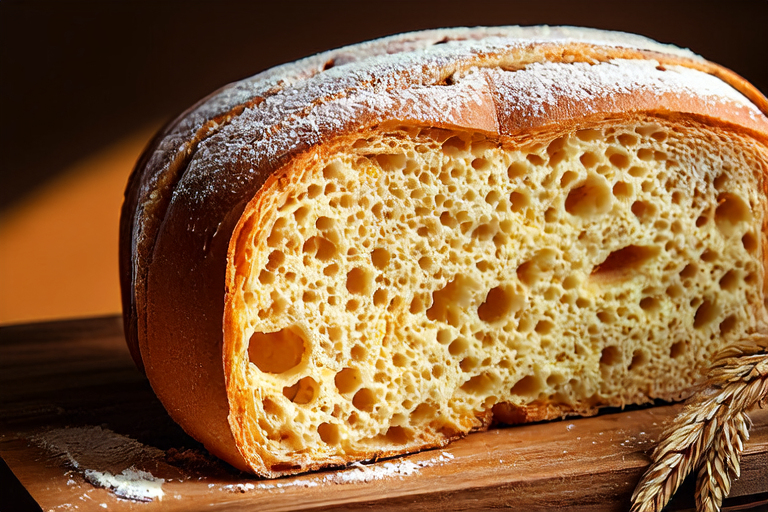- The Art of Bread: A Homemade Sourdough Bakery Special
Introduction
Welcome to the world of artisanal bread baking! This article delves into the intricate art of creating homemade sourdough, a process that not only requires patience but also a deep understanding of the science behind it. From the initial stages of cultivating your starter to the final shaping and baking, we will guide you through every step, ensuring that your efforts culminate in a loaf that is both visually stunning and deliciously satisfying.
The Magic of Sourdough
Sourdough bread has a long and storied history, dating back thousands of years. It is made using a natural leavening agent known as a sourdough starter, which is essentially a symbiotic culture of wild yeast and lactic acid bacteria. This unique combination gives sourdough its distinctive tangy flavor and chewy texture. Unlike commercial yeast, which can be purchased in packets, a sourdough starter is a living organism that needs to be nurtured and fed regularly.
Creating a successful sourdough starter is an essential first step in the process. It involves mixing equal parts flour and water and allowing the mixture to sit at room temperature for several days. During this time, wild yeasts and bacteria from the air and flour begin to colonize the mixture. Initially, the mixture may look stagnant, but after a few days, bubbles will start to form, indicating the presence of active yeast. Once your starter is bubbly and doubles in size within a few hours after feeding, it is ready to use.
Selecting the Right Ingredients
Choosing high-quality ingredients is crucial when making sourdough bread. The type of flour you use can significantly impact the taste and texture of your bread. For a classic sourdough loaf, bread flour is often preferred due to its higher protein content, which results in a chewier crust and better rise. However, all-purpose flour can also be used for a softer crumb.
In addition to flour, the quality of your water plays a vital role. Ideally, use filtered or bottled water with a neutral pH, as tap water can contain chlorine or other chemicals that may affect the fermentation process. Salt is another key ingredient, providing structure and enhancing the flavor of the dough. Use a fine-grained sea salt for the best results.
Building Your Starter
Before diving into the actual bread-making process, let’s focus on building and maintaining your sourdough starter. As mentioned earlier, creating a starter involves mixing equal parts flour and water and leaving the mixture at room temperature for several days. During this time, the mixture should be fed daily by discarding half of it and adding fresh flour and water.
Once your starter is active and doubling in size within a few hours after feeding, it’s time to incorporate it into your bread recipe. For a standard 750g loaf, you will need approximately 300g of mature starter. Remember to maintain a small portion of your starter for future use, feeding it regularly even when you’re not baking.
The Baking Process
Now that you have your starter ready, it’s time to move on to the actual bread-making process. Begin by mixing the starter, flour, and water in a large bowl. Knead the dough for about 10 minutes until it becomes smooth and elastic. Then, cover the bowl with a damp cloth and let the dough rest for an hour.
After the initial resting period, gently fold the dough over itself a few times to redistribute the gases. Cover the bowl again and let it rest for another hour. Repeat this folding process two more times, each followed by a one-hour rest. This series of folds and rests is known as the “stretch and fold” technique, which helps develop the gluten in the dough and create a well-structured loaf.
Once the dough has completed its final rest, shape it into a round ball and place it seam-side down in a proofing basket lined with a floured linen cloth. Allow the dough to proof for several hours until it has doubled in size. During this time, preheat your oven to 475°F (245°C) and prepare a Dutch oven or baking stone for baking.
When the dough is fully proofed, carefully transfer it to the preheated oven. If using a Dutch oven, place it upside down in the oven and bake for 30 minutes with the lid on. Then, remove the lid and continue baking for another 15-20 minutes until the crust is golden brown and the internal temperature reaches 205°F (96°C).
Shaping and Scoring
Proper shaping and scoring are essential steps that contribute to the visual appeal and structural integrity of your sourdough loaf. After the final stretch and fold, gently shape the dough into a round or oval shape, depending on your preference. To achieve a round shape, gather the edges of the dough and pinch them together at the bottom. For an oval shape, flatten the dough slightly and roll it up like a jelly roll before sealing the edges.
Once shaped, place the dough seam-side down in a proofing basket lined with a floured linen cloth. Let it proof for several hours until it has doubled in size. Before transferring the dough to the oven, carefully invert it onto a piece of parchment paper and score the top with a sharp knife or lame. Scoring allows the dough to expand evenly during baking and creates decorative patterns on the crust.
Baking Tips and Tricks
To ensure the best possible outcome, follow these tips:
- Use a thermometer to check the internal temperature of the bread. It should reach 205°F (96°C) for optimal flavor and texture.
- Preheat your oven thoroughly and use a Dutch oven or baking stone to retain moisture and create a steamy environment, which helps develop a crisp crust.
- Avoid opening the oven door too frequently during the initial stages of baking, as this can cause the dough to collapse.
- Let the bread cool completely on a wire rack before slicing to allow the crumb to set properly.
Conclusion
Making homemade sourdough bread is a rewarding and fulfilling experience that combines artistry, science, and craftsmanship. By following the steps outlined in this guide, you can create a loaf that is not only delicious but also a testament to your dedication and skill. Remember, the key to successful sourdough baking lies in patience and attention to detail. Happy baking!


